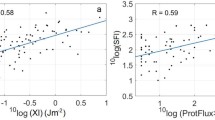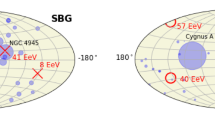Abstract
Concurrent interplanetary magnetic field and 0.7–7.6 MeV proton cosmic-ray anisotropy data obtained from instrumentation on Explorers 34 and 41 are examined for five cosmic-ray events in which we observe a persistent eastern-anisotropy phase late in the event (t ≳ 4 days). The direction of the anisotropy at such times shows remarkable invariance with respect to the direction of the magnetic field (which generally varies throughout the event) and it is also independent of particle species (electrons and protons) and particle speed over the range 0.06 ⩽ β ⩽ 0.56. The anisotropy is from the direction 38.3° ± 2.4° E of the solar radius vector, and is inferred to be orthogonal to the long term, mean interplanetary field direction. Both the amplitude of the anisotropy and the decay time constant show a strong dependence on the magnetic field azimuth. Detailed comparison of the anisotropy and the magnetic field data shows that the simple model of convection plus diffusion parallel to the magnetic field is applicable for this phase of the flare effect.
It is demonstrated that contemporary theories do not predict the invariance of the direction as observed, even when the magnetic field is steady; these theories need extension to take into account the magnetic field direction ψ varying from its mean direction ψ o. It is shown that the late phase anisotropy vector is not expected to be everywhere perpendicular to the mean magnetic field. The suggestion that we are observing kinks in the magnetic field moving radially outwards from the Sun leads to the conclusion that the parallel diffusion coefficient varies as 1/cos2 (ψ − ψ o). Density gradients in the late decay phase are estimated to be ≈ 700%∣AU for 0.7–7.6 MeV protons. A simple theory reproduces the dependence of the decay time constant on anisotropy; it also leads to a radial density gradient of about 1000%∣AU and diffusion coefficient of 1.3 × 1020 cm2 s−1.
Similar content being viewed by others
References
Allum, F. R., Palmeira, R. A. R., Rao, U. R., McCracken, K. G., Harries, J. R., and Palmer, I.: 1971, Solar Phys. 17, 241.
Axford, W. I.: 1969, Seminar on the Problem of Cosmic Ray Generation on the Sun, Leningrad, 1969.
Bartley, W. C., McCracken, K. G., Rao, U. R., Harries, J. R., Palmeira, R. A. R., and Allum, F. R.: 1971, Solar Phys. 17, 218.
Fairfield, D. H.: 1969, J. Geophys. Res. 74, 3541.
Fairfield, D. H. and Ness, N. F.: 1972, J. Geophys. Res. 77, 611.
Forman, M. A.: 1970a, J. Geophys. Res. 75, 3147.
Forman, M. A.: 1970b, Planetary Space Sci. 18, 25.
Gleeson, L. J. and Axford, W. I.: 1969, Astrophys. Space Sci. 2, 431.
Innanen, W. G. and Van Allen, J. A.: 1973, J. Geophys. Res. 78, 1019.
McCracken, K. G. and Rao, U. R.: 1970, Space Sci. Rev. 11, 155.
McCracken, K. G., Rao, U. R., and Bukata, R. P.: 1967, J. Geophys. Res. 72, 4293.
McCracken, K. G., Rao, U. R., and Ness, N. F.: 1968, J. Geophys. Res. 73, 4159.
McCracken, K. G., Rao, U. R., Bukata, R. P., and Keath, E. P.: 1971, Solar Phys. 18, 100.
Ness, N. F.: 1970, Proc. XI Int. Conf. on Cosmic Rays (Budapest), Invited Papers, p. 41.
Ng, C. K.: 1972, Ph.D. Thesis, Monash University, Victoria, Australia.
Ng. C. K., and Gleeson, L. J.: 1971a, Proc. XII Int. Conf. on Cosmic Rays (Hobart) 2, 499.
Ng. C. K. and Gleeson, L. J.: 1971b, Solar Phys. 20, 166.
Pyle, K. Roger: 1973, J. Geophys. Res. 78, 12.
Rao, U. R., McCracken, K. G., Allum, F. R., Palmeira, R. A. R., Bartley, W. C., and Palmer, I. D.: 1971, Solar Phys. 19, 209.
Rao, U. R., Allum, F. R., and McCracken, K. G.: 1973, J. Geophys. Res. 78, 8409.
Roelof, E. C.: 1973, Proc. of Calgary Conf. on Solar-Terrestrial Relations, Calgary, August 1972, p. 411.
Wibberenz, G.: 1971, Proc. XII Int. Conf. on Cosmic Rays (Hobart), Rapporteur paper.
Roelof, E. C. and Krimigis, S. M.: 1973, J. Geophys. Res. 78, 5375.
Wolfe, J. H.: 1972, in C. P. Sonett, P. J. Coleman and J. M. Wilcox, (eds.), Solar Wind, NASA- SP-308, 170.
Author information
Authors and Affiliations
Rights and permissions
About this article
Cite this article
Allum, F.R., Palmeira, R.A.R., McCracken, K.G. et al. Cosmic ray anisotropies observed late in the decay phase of solar flare events. Sol Phys 38, 227–256 (1974). https://doi.org/10.1007/BF00161840
Received:
Revised:
Issue Date:
DOI: https://doi.org/10.1007/BF00161840




